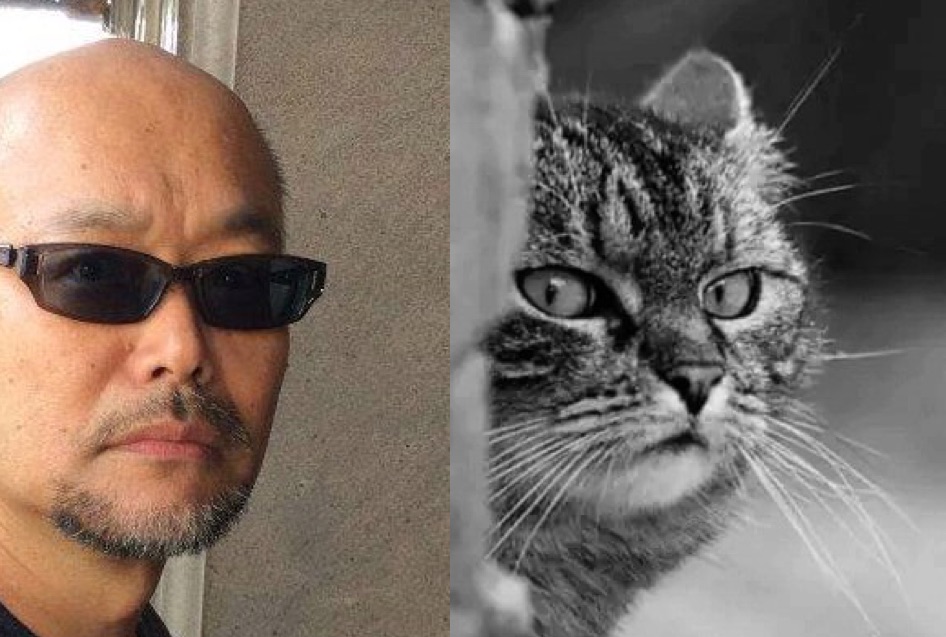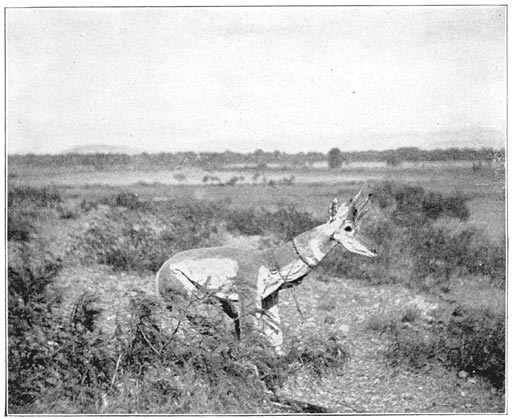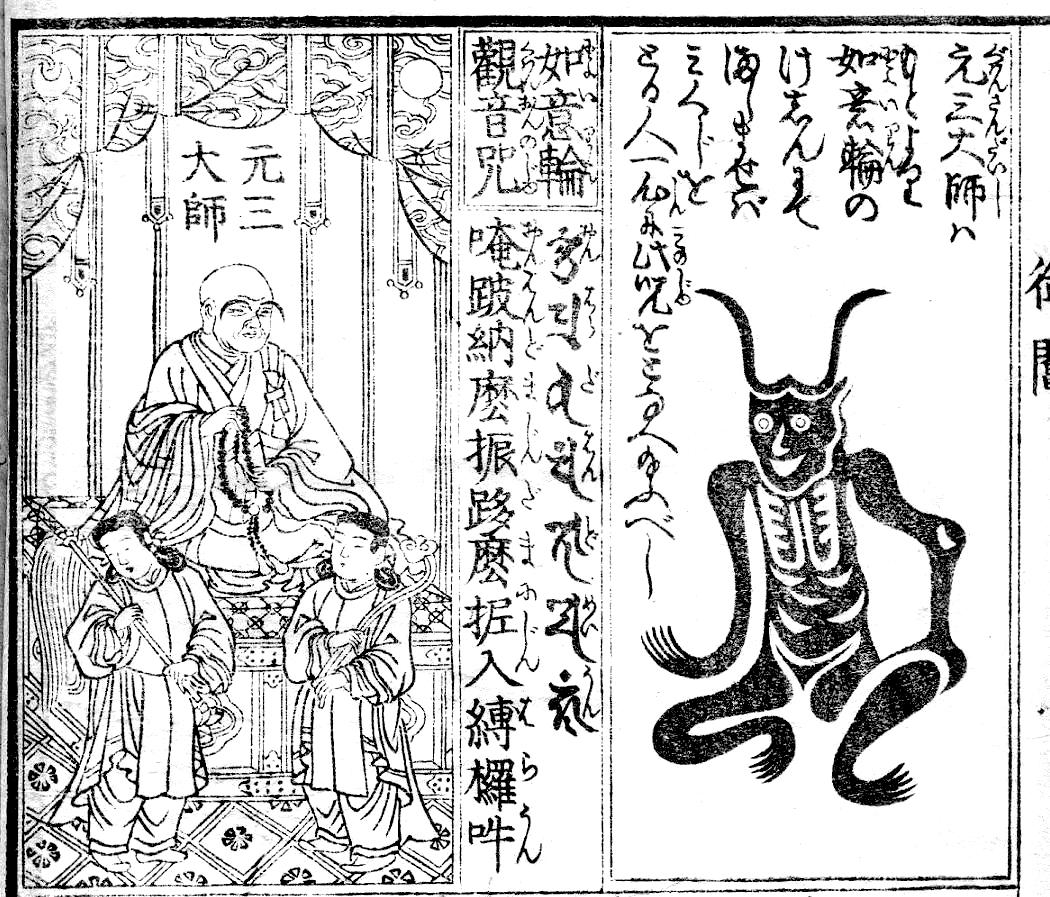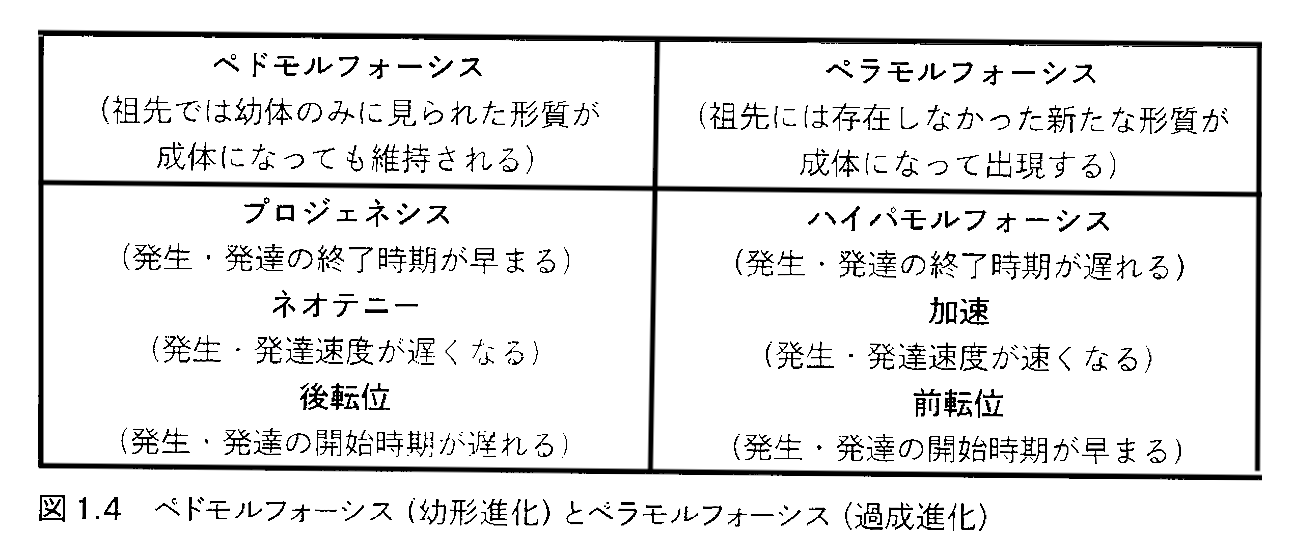
メタモルフォシスとアナモルフォシス
Between metamorphosis and Anamorphosis

人間以外の事物・動物を、人間界に包摂しようとする 擬人化に対して、人間そのものが、事物や動物になろうとする発想ないしは哲 学という ものがある。先に挙げた、擬猫化/擬犬化が、それである。ここではそれを擬動物化(Theriomorphism, animalization)と 呼ん でおこう――これらの造語は私のオリジナルである。擬動物化はかれらの形態を模倣ないしは同一化ということからなりたつので、人間が動物に変化した後には 人間語の使用はそれほどみられない。現在のところ、私たちが知っている擬動物化の技法は、変身=変態(metamorphosis)と異種扮装 (anamorphosis)である。言い換えると、変身=変態は「メタモルフォシス」であり、異種扮装は「アナモルフォシス」である。変態=メタモル フォシスは身体が変形して元の身体とは別の身体に組織編成することであるのに対して、後者の異種扮装=アナモルフォシスには、例えば人間が コスプレで虎になるのだと称して、虎縞の毛皮のビキニを着て、つけ鼻をつけ、鼻の横に髭を描けば、それは立派な異種扮装になる。ちなみに、完全に変態した り、異種扮装でも変身が完璧になれば、もはやそれは動物の擬態ではなく、動物そのものになることは言うまでもない。
▲人間がアナモルフォシスを試みる理由は様々である。 まず、鹿を生け捕りにする猟師が鹿に変身することを想起してみよう。実際の例である。カサス・グランデスのこの老狩猟師は動物の衣装を身 に纏った時に、どれだけアンテロープの「気分」になっている(=まさに変心)してるのだろうか?カール・ロムホルツ(1902)『知られざるメキシコ』か らの記述である。
The plains of San Diego used to swarm with antelopes, and even at the time of my visit herds of them could be seen now and then. One old hunter near Casas Grandes resorted to an ingenious device for decoying them. He disguised himself as an antelope, by means of a cloak of cotton cloth (manta) painted to resemble the colouring of the animal. This covered his body, arms, and legs. On his head he placed the antlers of a stag, and by creeping on all fours he could approach the antelopes quite closely and thus successfully shoot them. The Apaches, according to the Mexicans, were experts at hunting antelopes in this manner.(p.84)- Unknown Mexico, Carl Lumholtz (1902).
サンディエゴの平原にはかつてアンテロープが群れを
なしており、私が訪れた当時も、時折その群れを見ることができた。カサス・グランデス近郊のある老猟師は、カモシカをおびき寄せるために巧妙な工夫をし
た。カモシカの色に似せた綿布(マンタ)のマントで、カモシカに変装したのだ。胴体、腕、脚を覆っている。四つん這いになってアンテロープに近づくと、う
まく撃つことができた。メキシコ人によれば、アパッチ(族)はこの方法でアンテロープを狩る専門家であったという。
それに添えられた写真である。キャプションにはこう書かれてある:A DEER disguised by old deer hunter of San Diego - Unknown Mexico, Carl Lumholtz(1902)



▲▲右の図像は、良源=
元三大師と角大師(『天明改正 元三大師御鬮繪抄』1785年仙鶴堂発行、であるが、元三大師(諡号:慈恵大師)観音の化身とも言われており、観音はあら
ゆる衆生を救うために33の姿に化身する。また、2本の角を持ち骨と皮とに痩せさらばえた夜叉の像を表したものと、眉毛が角のように伸びたものの2つの表
象化されている。『元三大師縁起』によると、良源が夜叉の姿に化しているのは、疫病
神そのものになったわけでなく、本物の疫病神になったわけでなく(中身
は大師のまま)本物の疫病を追い払った時の像であるという。最後は、The Transfigured Christ (1513)
by Andrea
Previtali.
▲▲▲右の最後の絵画は、アンドレア・プレヴィタリ の作品で、キリストの処刑・埋葬後の復活を意味するが、絵画の表題は『姿を変えるキリスト』とある。キリストは生前生きたままの姿として弟子たちの前にあ らわれるが、そのことは誰も気がつかなかった。なぜなら、キリストの死とその骸(むくろ)の崩壊を、キリストの使徒たちは疑っていなかったからだ。正確に 言えば、使徒を含めて、誰もキリストが生前の姿をとどめて「復活」することなど信じなかった。それゆえに、キリストの復活のテーマは、聖母マリアの処女懐 胎のように、非現実的でシュールレアリズム的なものとしてしか、現世の我々は「解釈」する他はないのである。したがって、この場合の『姿を変えるキリス ト』は、後の信徒たちが「そうなったらいいな」という希望的願望であり、多くのキリスト教会は、常識では考えられない処女懐胎とキリストの復活を、みずか らの信条告白(=パフォーマティブな言語行為)として受け入れている。
★アナモルフォシス、例えば、アマゾンのシャーマン が、裸体に黒い複数の●を描きこんでジャガーと一体化するのに、我々それを未開で原始的なものだと思えるだろうか。我々は、中に人がいるだろうが、獅子舞 の獅子に子供のあたまを齧らせて我が子の健勝を祈らないだろうか。もっと卑近でユニークな例がある。アマゾンやユニクロの潜入取材で、秀逸なルポルター ジュを書いた横田増生氏は、ユニクロに潜入取材を行っている最中に、職場での制服化しているユニクロの服を着たいと思わなかった。それは、取材先のユニク ロのブラックさを暴きたいという取材魂から着ている。しかし、そんな彼も心を変える。ブラックさを客体化するではなく、ユニクロの企業文化を生きるとはど のようなものかと、考え直した時である。次の横田氏の発言はとても示唆に富む。
「当初、私はユニクロで働くときだけ、ユニクロの商 品を着るようにし、それ以外は、絶対に着るもんかと思っていた。しかし、働いている間中、ユニクロを私服としてきるのはおもしろい、とすぐに思い直した。 働くだけでなく、消費者の視点からもユニクロという企業を見ることができると考え方からだ」(横田 2017:71)
それに対する、バイト先の店長の様子はこうだったという:(/は改行)「翌日、布袋店長は私 が前日買った服を着ているのを見て、/『うん、似合う、似合う』とご満悦の様子」( ibid.)
衣装を着るという人間のアナモルフォシスが、その着
る人の内的アイデンティティ(inner identity)の外部表象(outer
representation)として機能したり、文化人類学(民族誌学)の調査のように、対象民族や文化(=この場合はユニクロ・カルチャー)と
同一化することを通した「さらなるステップ」へと進むことを示している。
| Metamorphosis is a
biological process by which an animal physically develops including
birth transformation or hatching, involving a conspicuous and
relatively abrupt change in the animal's body structure through cell
growth and differentiation.[1] Some insects, fish, amphibians,
mollusks, crustaceans, cnidarians, echinoderms, and tunicates undergo
metamorphosis, which is often accompanied by a change of nutrition
source or behavior.[2] Animals can be divided into species that undergo
complete metamorphosis ("holometaboly"), incomplete metamorphosis
("hemimetaboly"), or no metamorphosis ("ametaboly").[3] Scientific usage of the term is technically precise, and it is not applied to general aspects of cell growth, including rapid growth spurts. Generally organisms with a larval stage undergo metamorphosis, and during metamorphosis the organism loses larval characteristics. [4] References to "metamorphosis" in mammals are imprecise and only colloquial, but historically idealist ideas of transformation and morphology, as in Goethe's Metamorphosis of Plants, have influenced the development of ideas of evolution. |
変態(へんたい、英:
metamorphosis)とは、動物が物理的に成長する生物学的プロセスのことで、出生時の変化や孵化を含み、細胞の成長と分化によって動物の身体構
造が顕著かつ比較的急激に変化することをいう。
[1]昆虫、魚、両生類、軟体動物、甲殻類、刺胞動物、棘皮動物、被殻動物などの一部が変態し、栄養源や行動の変化を伴うことが多い[2]
動物は、完全変態(「holometaboly」)をする種、不完全変態(「hemimetaboly」)、変態しない(「ameraboly」)に分け
ることができる[3] 。 この用語の科学的な使用は技術的に正確であり、急成長を含む細胞成長の一般的な側面には適用されない。一般に幼生期のある生物は変態し、変態の過程で幼生 期の特徴を失っていく。[哺乳類における「変態」への言及は不正確で口語的なものに過ぎないが、ゲーテの『植物の変態』のように、歴史的に変態や形態に関 する理想主義の考え方は、進化に関する考え方の発展に影響を与えたと言える。 |
| Etymology The word metamorphosis derives from Ancient Greek μεταμόρφωσις, "transformation, transforming",[5] from μετα- (meta-), "after" and μορφή (morphe), "form".[6] |
語源について メタモルフォーゼの語源は、古代ギリシャ語のμεταμόρφωσις「変容、変形」であり、μετα-(meta-)の「後」とμορφή (morphe)の「形」に由来する[5]。 |
| Hormonal control In insects, growth and metamorphosis are controlled by hormones synthesized by endocrine glands near the front of the body (anterior). Neurosecretory cells in an insect's brain secrete a hormone, the prothoracicotropic hormone (PTTH) that activates prothoracic glands, which secrete a second hormone, usually ecdysone (an ecdysteroid), that induces ecdysis (shedding of the exoskeleton).[7] PTTH also stimulates the corpora allata, a retrocerebral organ, to produce juvenile hormone, which prevents the development of adult characteristics during ecdysis. In holometabolous insects, molts between larval instars have a high level of juvenile hormone, the moult to the pupal stage has a low level of juvenile hormone, and the final, or imaginal, molt has no juvenile hormone present at all.[8] Experiments on firebugs have shown how juvenile hormone can affect the number of nymph instar stages in hemimetabolous insects.[9][10] Metamorphosis is iodothyronine-induced and an ancestral feature of all chordates.[11] |
ホルモンの制御 昆虫の成長や変態は、体の前方にある内分泌腺で合成されるホルモンによって制御されている。昆虫の脳の神経分泌細胞は、前胸腺を活性化する前胸腺刺激ホル モン(PTTH)を分泌し、前胸腺は第二のホルモン、通常はエクジソン(エクジステロイド)を分泌し、脱皮(外骨格の脱落)を誘導する[7]。PTTH は、後頭部器官のアラタ体も刺激してジュビナイルホルモンを分泌し、脱皮中に大人の特徴が発達しないよう促す。半翅目昆虫では、幼虫期の脱皮は幼若ホルモ ンが多く、蛹期への脱皮は幼若ホルモンが少なく、最後の脱皮(想像脱皮)は幼若ホルモンが全くない[8]。ヒグラシを使った実験では、半翅目昆虫のニンフ 期の数に幼若ホルモンがいかに影響するかが示されています[9][10]。 変態はヨードサイロニンによって誘導され、すべての脊索動物の祖先的特徴である[11]。 |
| Insects All three categories of metamorphosis can be found in the diversity of insects, including no metamorphosis ("ametaboly"), incomplete or partial metamorphosis ("hemimetaboly"), and complete metamorphosis ("holometaboly"). While ametabolous insects show very little difference between larval and adult forms (also known as "direct development"), both hemimetabolous and holometabolous insects have significant morphological and behavioral differences between larval and adult forms, the most significant being the inclusion, in holometabolus organisms, of a pupal or resting stage between the larval and adult forms. |
昆虫 昆虫の変態には、変態しないもの(「アメトーーク」)、不完全・部分変態(「ヘミメタボ」)、完全変態(「ホロメタボ」)の3種類があり、いずれも多様性 がある。アメフラシは幼虫と成虫の間にほとんど差がない(「直接発生」ともいう)のに対し、ヘミメタボとホロメタボは幼虫と成虫の間に形態的・行動的に大 きな差があり、ホロメタボでは幼虫と成虫の間に蛹期や休息期を持つことが最も重要である。 |
| Development and terminology In hemimetabolous insects, immature stages are called nymphs. Development proceeds in repeated stages of growth and ecdysis (moulting); these stages are called instars. The juvenile forms closely resemble adults, but are smaller and lack adult features such as wings and genitalia. The size and morphological differences between nymphs in different instars are small, often just differences in body proportions and the number of segments; in later instars, external wing buds form. The period from one molt to the next is called a stadium.[12] In holometabolous insects, immature stages are called larvae and differ markedly from adults. Insects which undergo holometabolism pass through a larval stage, then enter an inactive state called pupa (called a "chrysalis" in butterfly species), and finally emerge as adults.[13] |
展開と用語 半変態の昆虫では、未熟な段階をニンフと呼びます。成長期と脱皮期を繰り返しながら発達し、その段階を「齢」という。幼虫は成虫によく似ているが、小さ く、翅や生殖器などの成虫の特徴もない。幼虫の大きさや形態的な違いは小さく、体の比率や節数の違いだけであることが多く、幼虫の後半には外翅芽が形成さ れる。ある脱皮から次の脱皮までの期間をスタミナと呼ぶ[12]。 ホロメタボリックな昆虫では、未熟な段階は幼虫と呼ばれ、成虫とは顕著に異なる。ホロメタボリズムをとる昆虫は、幼虫期を経て、蛹(蝶の仲間では「さな ぎ」と呼ばれる)と呼ばれる不活性状態になり、最後に成虫として出てくる[13]。 |
| Evolution The earliest insect forms showed direct development (ametabolism), and the evolution of metamorphosis in insects is thought to have fuelled their dramatic radiation (1,2). Some early ametabolous "true insects" are still present today, such as bristletails and silverfish. Hemimetabolous insects include cockroaches, grasshoppers, dragonflies, and true bugs. Phylogenetically, all insects in the Pterygota undergo a marked change in form, texture and physical appearance from immature stage to adult. These insects either have hemimetabolous development, and undergo an incomplete or partial metamorphosis, or holometabolous development, which undergo a complete metamorphosis, including a pupal or resting stage between the larval and adult forms.[14] A number of hypotheses have been proposed to explain the evolution of holometaboly from hemimetaboly, mostly centering on whether or not the intermediate stages of hemimetabolous forms are homologous in origin to the pupal stage of holometabolous forms. |
進化 昆虫の初期形態は直接発生(アメトーーク)であり、昆虫の変態進化が昆虫の飛躍的な成長を促したと考えられている(1,2)。初期のアメフラシを持つ「真 正昆虫」の中には、現在でもブリキムシやシルバーフィッシュのようなものが存在する。ヘミメタボリックな昆虫には、ゴキブリ、バッタ、トンボ、真性昆虫な どがいる。系統的には、翼手類に属するすべての昆虫は、未熟な段階から成虫になるまで、形態や質感、体裁が著しく変化する。これらの昆虫は、半代謝性発達 で不完全または部分的な変態をするか、全代謝性発達で幼虫と成虫の間の蛹または休息期を含む完全な変態をするかである[14]。 ヘミメタボリックからホロメタボリックへの進化を説明するために多くの仮説が提案されているが、その多くは、ヘミメタボリックの中間段階がホロメタボリッ クの蛹の段階と相同な起源であるかどうかが中心である。 |
| Recent research According to research from 2008, adult Manduca sexta is able to retain behavior learned as a caterpillar.[16] Another caterpillar, the ornate moth caterpillar, is able to carry toxins that it acquires from its diet through metamorphosis and into adulthood, where the toxins still serve for protection against predators.[17] Many observations published in 2002, and supported in 2013 indicate that programmed cell death plays a considerable role during physiological processes of multicellular organisms, particularly during embryogenesis, and metamorphosis.[18][19] Additional research in 2019 found that both autophagy and apoptosis, the two ways programmed cell death occur, are processes undergone during insect metamorphosis. [20] Below is the sequence of steps in the metamorphosis of the butterfly (illustrated): Metamorphosis of butterfly (PSF) 1 – The larva of a butterfly 2 – The pupa is now spewing the thread to form chrysalis 3 – The chrysalis is fully formed 4 – Adult butterfly coming out of the chrysalis |
最近の研究 2008年の研究によると、マンドゥカ・セクスタの成虫は、イモムシのときに学んだ行動を保持することができる[16]。別のイモムシ、オナガイモムシ は、食事から得た毒素を変態を経て成虫まで運ぶことができ、毒素は捕食者から守るためにまだ役立つ[17]。 2002年に発表され、2013年に支持された多くの観察結果は、プログラムされた細胞死が多細胞生物の生理的過程、特に胚形成と変態の間にかなりの役割 を果たすことを示している[18][19] 2019年の追加研究により、プログラムされた細胞死を起こす二つの方法であるオートファジーとアポトーシスは両方とも、昆虫の変態中に受ける過程である ことがわかった。[20] 以下は、蝶の変態の一連の流れです(図解): 蝶の変態(PSF) 1 - 蝶の幼虫 2 - 蛹が糸を吐いて蛹を形成する段階 3 - さなぎが完全に形成される 4 - 成虫が蛹から出てくるところ |
| Chordata Amphioxus In cephalochordata, metamorphosis is iodothyronine-induced and it could be an ancestral feature of all chordates.[11] Fish Some fish, both bony fish (Osteichthyes) and jawless fish (Agnatha), undergo metamorphosis. Fish metamorphosis is typically under strong control by the thyroid hormone.[21] Examples among the non-bony fish include the lamprey. Among the bony fish, mechanisms are varied. The salmon is diadromous, meaning that it changes from a freshwater to a saltwater lifestyle. Many species of flatfish begin their life bilaterally symmetrical, with an eye on either side of the body; but one eye moves to join the other side of the fish – which becomes the upper side – in the adult form. The European eel has a number of metamorphoses, from the larval stage to the leptocephalus stage, then a quick metamorphosis to glass eel at the edge of the continental shelf (eight days for the Japanese eel), two months at the border of fresh and salt water where the glass eel undergoes a quick metamorphosis into elver, then a long stage of growth followed by a more gradual metamorphosis to the migrating phase. In the pre-adult freshwater stage, the eel also has phenotypic plasticity because fish-eating eels develop very wide mandibles, making the head look blunt. Leptocephali are common, occurring in all Elopomorpha (tarpon- and eel-like fish). Most other bony fish undergo metamorphosis initially from egg to immotile larvae known as sac fry (fry with a yolk sac), then to motile larvae (often known as fingerlings due to them roughly reaching the length of a human finger) that have to forage for themselves after the yolk sac resorbs, and then to the juvenile stage where the fish progressively start to resemble adult morphology and behaviors until finally reaching sexual maturity.[22][23] |
脊索動物門 両生類 頭索動物では、変態はヨードサイロニンによって誘導され、それはすべての脊索動物の祖先の特徴である可能性がある[11]。 魚類 魚類の中には、骨魚類(Osteichthyes)と無顎類(Agnatha)の両方が変態をするものがある。魚類の変態は、一般的に甲状腺ホルモンによ る強い制御下にある[21]。 非骨魚類の例としては、ヤツメウナギが挙げられる。硬骨魚類では、その仕組みはさまざまである。 サケはディアドロマス性で、淡水から海水へと生活様式を変えることを意味する。 ヒラメの多くの種は、最初は体の左右に目がある左右対称の生活をしているが、成魚になると片方の目が移動して反対側(上側となる)に合流する。 ヨーロッパウナギは、幼生期からレプトセファルス期、大陸棚の端でシラスウナギに素早く変態し(ニホンウナギは8日間)、淡水と海水の境界で2ヶ月、シラ スウナギがエルバーに素早く変態し、その後長い成長期を経てより緩やかに変態し移動する段階と、多くの変態を繰り返している。成体前の淡水期では、魚食性 のウナギは大あごが非常に広くなり、頭部が鈍重に見えるため、表現型の可塑性も持っています。レプトセファリは一般的で、すべてのElopomorpha (タウナギやウナギに似た魚)で発生する。 他のほとんどの骨魚は、卵からサックフライ(卵黄嚢を持つ稚魚)と呼ばれる不動性の幼生に始まり、卵黄嚢が吸収された後に自給自足しなければならない運動 性の幼生(人間の指の長さに達することからフィンガーリングと呼ばれることが多い)、そして徐々に大人の形態や行動に似てくる幼生期へと変態を遂げ、最後 に性成熟に至ります [22] [23] 。 |
| Amphibians In typical amphibian development, eggs are laid in water and larvae are adapted to an aquatic lifestyle. Frogs, toads, and newts all hatch from the eggs as larvae with external gills but it will take some time for the amphibians to interact outside with pulmonary respiration. Afterwards, newt larvae start a predatory lifestyle, while tadpoles mostly scrape food off surfaces with their horny tooth ridges. Metamorphosis in amphibians is regulated by thyroxin concentration in the blood, which stimulates metamorphosis, and prolactin, which counteracts its effect. Specific events are dependent on threshold values for different tissues. Because most embryonic development is outside the parental body, development is subject to many adaptations due to specific ecological circumstances. For this reason tadpoles can have horny ridges for teeth, whiskers, and fins. They also make use of the lateral line organ. After metamorphosis, these organs become redundant and will be resorbed by controlled cell death, called apoptosis. The amount of adaptation to specific ecological circumstances is remarkable, with many discoveries still being made. Frogs and toads With frogs and toads, the external gills of the newly hatched tadpole are covered with a gill sac after a few days, and lungs are quickly formed. Front legs are formed under the gill sac, and hindlegs are visible a few days later. Following that there is usually a longer stage during which the tadpole lives off a vegetarian diet. Tadpoles use a relatively long, spiral‐shaped gut to digest that diet. Recent studies suggest tadpoles don't have a balanced homeostatic feedback control system until the beginning stages of metamorphosis. At this point, their long gut shortens and begins favoring the diet of insects.[24] Rapid changes in the body can then be observed as the lifestyle of the frog changes completely. The spiral‐shaped mouth with horny tooth ridges is resorbed together with the spiral gut. The animal develops a big jaw, and its gills disappear along with its gill sac. Eyes and legs grow quickly, a tongue is formed, and all this is accompanied by associated changes in the neural networks (development of stereoscopic vision, loss of the lateral line system, etc.) All this can happen in about a day, so it is truly a metamorphosis. It is not until a few days later that the tail is reabsorbed, due to the higher thyroxin concentrations required for tail resorption. |
両生類 典型的な両生類の発生では、卵は水中に産み落とされ、幼虫は水中での生活に適応するようになります。カエル、ヒキガエル、イモリはすべて外鰓を持つ幼生と して卵から孵化しますが、両生類が肺呼吸で外界と交流するようになるまでにはしばらく時間がかかります。その後、イモリの幼虫は捕食生活を始め、オタマ ジャクシは主に角質のある歯の隆起で表面から食べ物を削り取る。 両生類の変態は、変態を促す血中チロキシン濃度と、その効果を打ち消すプロラクチンによって制御されている。具体的な事象は、各組織の閾値に依存する。胚 の発達のほとんどは親の体外で行われるため、発達は特定の生態的状況による多くの適応を受ける。このため、オタマジャクシは歯、ヒゲ、ヒレのための角質の 隆起を持つことができる。また、側線器官を利用することもある。変態後、これらの器官は冗長になり、アポトーシスと呼ばれる制御された細胞死によって吸収 される。特定の生態環境に適応する量の多さには目を見張るものがあり、今も多くの発見がなされている。 カエルとヒキガエル カエルやヒキガエルでは、孵化したばかりのオタマジャクシの外側のエラは、数日後に鰓嚢で覆われ、肺が急速に形成されます。前足は鰓嚢の下で形成され、数 日後には後脚が見えるようになる。その後、オタマジャクシが菜食で生活する期間が長くなるのが普通である。オタマジャクシは、比較的長い螺旋状の腸を使っ て食事を消化する。最近の研究では、オタマジャクシは変態の初期段階まで、バランスのとれた恒常性フィードバック制御システムを持っていないことが示唆さ れています。この時点で、長い腸が短くなり、昆虫の食事を好むようになる[24]。 その後、カエルのライフスタイルが完全に変化するにつれて、体の急激な変化が観察されます。角質の歯の隆起がある螺旋状の口は、螺旋状の腸と一緒に吸収さ れる。大きな顎ができ、鰓嚢(えらのう)と共に鰓が消失する。目や足が急速に成長し、舌が形成され、それに伴う神経ネットワークの変化(立体視の発達、側 線システムの喪失など)が起こる。尾の再吸収に必要なチロキシン濃度が高くなるため、尾が再吸収されるのは数日後である。 |
| Salamanders Salamander development is highly diverse; some species go through a dramatic reorganization when transitioning from aquatic larvae to terrestrial adults, while others, such as the axolotl, display pedomorphosis and never develop into terrestrial adults. Within the genus Ambystoma, species have evolved to be pedomorphic several times, and pedomorphosis and complete development can both occur in some species.[21] Newts In newts, metamorphosis occurs due to the change in habitat, not a change in diet, because newt larvae already feed as predators and continue doing so as adults. Newts' gills are never covered by a gill sac and will be resorbed only just before the animal leaves the water. Adults can move faster on land than in water.[25] Newts often have an aquatic phase in spring and summer, and a land phase in winter. For adaptation to a water phase, prolactin is the required hormone, and for adaptation to the land phase, thyroxin. External gills do not return in subsequent aquatic phases because these are completely absorbed upon leaving the water for the first time. Caecilians Basal caecilians such as Ichthyophis go through a metamorphosis in which aquatic larva transition into fossorial adults, which involves a loss of the lateral line.[26] More recently diverged caecilians (the Teresomata) do not undergo an ontogenetic niche shift of this sort and are in general fossorial throughout their lives. Thus, most caecilians do not undergo an anuran-like metamorphosis.[27] |
サンショウウオ類 サンショウウオの発生は非常に多様で、水棲の幼生から陸棲の成体に移行する際に劇的な再編成を行う種もあれば、アキアカネなどのように変態を示し、陸棲の 成体に移行しないものもある。アンビストマ属では、種が何度も変態進化しており、種によっては変態と完全発達の両方が起こることがある[21]。 イモリ イモリの場合、イモリの幼虫はすでに捕食者として餌を食べ、成体になってもそれを続けるため、変態は食性の変化ではなく、生息環境の変化により起こる。イ モリのエラは鰓嚢に覆われることはなく、水から離れる直前にのみ再吸収される。成虫は水中よりも陸上の方が速く移動できる[25]。イモリは春から夏にか けて水棲期を、冬には陸棲期を持つことが多い。水相への適応にはプロラクチンが、陸相への適応にはサイロキシンが必要なホルモンである。外鰓は、初めて水 から出たときに完全に吸収されるため、その後の水棲期には戻ってこない。 アシナガバチ類 イクチオフィスなどの基部型アシナガバチは、水棲幼虫から化石成虫に移行する変態を行い、側線は失われる[26]が、最近分岐したアシナガバチ(テレソマ タ)は、この種の先天性ニッチシフトを行わず、生涯を通じて化石であることが一般的。したがって、ほとんどのアシナガバチは無尾類のような変態をしない [27]。 |
| Developmental biology – Study of
how organisms develop and grow Direct development – Growth to adulthood without metamorphosis Gosner stage – System of describing stages of development in anurans Hypermetamorphosis – High variability forms of complete metamorphosis Morphogenesis – Biological process that causes an organism to develop its shape |
発生生物学 - 生物がどのように発生し、成長するかを研究する。 直接発生 - 変態せずに成体まで成長すること。 ゴスナー期 -無尾類の発生段階を記述するシステム 超変態 - 完全変態の高変態形態。 形態形成 - 生物がその形を形成する生物学的プロセス |
| https://en.wikipedia.org/wiki/Metamorphosis |

出典:家畜化という進化 :
人間はいかに動物を変えたか / リチャード・C・フランシス著 ; 西尾香苗訳, 白揚社 , 2019, p.32
リンク
文献
その他の情報
Copyleft, CC, Mitzub'ixi Quq Chi'j, 1996-2099
☆
 ☆
☆